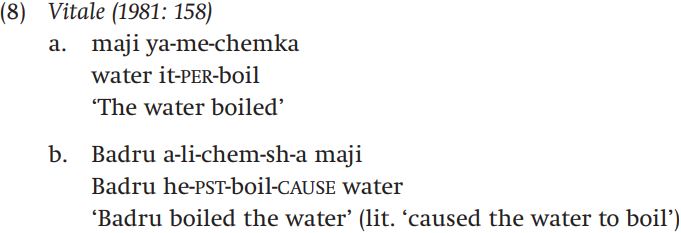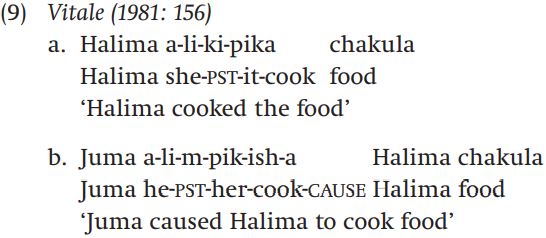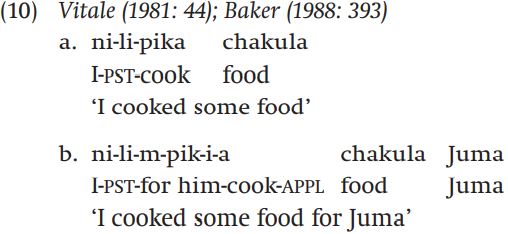


 Grammar
Grammar
 Tenses
Tenses
 Present
Present
 Past
Past
 Future
Future
 Parts Of Speech
Parts Of Speech
 Nouns
Nouns
 Verbs
Verbs
 Adverbs
Adverbs
 Adjectives
Adjectives
 Pronouns
Pronouns
 Pre Position
Pre Position
 Preposition by function
Preposition by function 
 Preposition by construction
Preposition by construction
 Conjunctions
Conjunctions
 Interjections
Interjections
 Grammar Rules
Grammar Rules
 Linguistics
Linguistics
 Semantics
Semantics
 Pragmatics
Pragmatics
 Reading Comprehension
Reading Comprehension|
Read More
Date: 2023-07-10
Date: 20-1-2022
Date: 2025-02-17
|
Passive and anti-passive morphology signal a reduction in the number of arguments that a verb has. There are other sorts of morphology that signal that arguments have been added to a verb.
Causatives signal the addition of a new subject argument, which semantically is the causer of the action. If the verb has only one argument to begin with, the causative sentence has two, and if it has two to begin with, the causative sentence has three arguments. Compare the Swahili sentences in (8) and (9):


In (8a), the verb ‘boil’ has only one argument, its patient/theme. In (8b), along with the causative morpheme -(i)sh , an external causer argument is added as the subject of the sentence. Similarly, in (9a), the verb ‘cook’ has two arguments, an agent (Halima) and a patient (‘food’); the agent is the subject of the sentence. When the causative suffix -(i)sh is added, a third argument (Juma) is added and it becomes the subject.
Applicative morphology, like causative morphology, signals the addition of an argument to the valency of a verb. But the added argument is an object, rather than a subject. We can again use Swahili for our example:

The suffix -i signals that a second object (Juma) has been added to the verb.
|
|
|
|
دخلت غرفة فنسيت ماذا تريد من داخلها.. خبير يفسر الحالة
|
|
|
|
|
|
|
ثورة طبية.. ابتكار أصغر جهاز لتنظيم ضربات القلب في العالم
|
|
|
|
|
|
|
العتبة العباسية المقدسة تقدم دعوة إلى كلية مزايا الجامعة للمشاركة في حفل التخرج المركزي الخامس
|
|
|